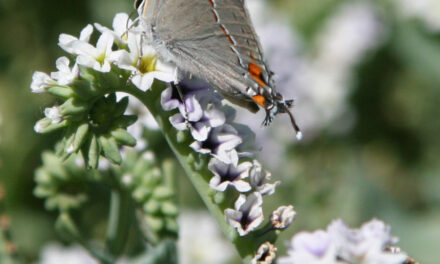Dominant male Tule elk have huge antlers spanning several feet in width and height. Magnificent appendages that are used in battle with other bulls during rut (the elk’s breeding season), antlers are almost always a part of any statue of the animal including the bronze elk in front of the headquarters and visitors center of the San Luis National Wildlife Refuge Complex.
As grand as they are, antlers are as seasonal and fleeting as snow on half dome when spring comes around. Elk shed them every year about this time and begin growing a new set almost immediately.
Yearling bulls can only manage to grow spikes during their first year because an animal’s age and the grandeur of its rack are proportional – older bulls have larger antlers.
It’s anything but dramatic when a big bull loses its antlers. They just detach from its skull and yield to gravity, sometimes one at a time leaving the animal lopsided about the head until the other rack falls. But they always fall off and then grow back.
Elk don’t have horns. A goat has horns, so does a rhinoceros and the continent of Africa. Horns – with the exceptions of French and fluegelhorns, double bell euphoniums, trumpets, tubas, other alternatively alloyed instruments and sundry woodwinds – are made of a boney core covered in a layer of keratin. Antlers are made entirely of bone.
An animal’s horns grow slowly over its lifetime, antlers grow quickly and then are shed. Both male and female animals grow horns, it’s usually only males that grow antlers. Antlers are often branched, horns are rarely so.
While they grow, antlers are covered with a layer of skin – often called velvet – that’s filled with blood vessels to nourish the growing bone. When antlers are fully grown, nourishment is no longer needed so blood stops flowing to them, and they harden. The velvet dies, dries up, splits, and becomes an itchy annoyance to the elk, which then thrash their antlers through the brush, fight with other elk, and generally toss their heads with vigor to shed the velvet as rut approaches.
Bull elk must eat huge amounts of food and nutrients to grow and carry around large antlers. A full-grown set of antlers will way about 40 pounds, give or take. A big rack means the bull is well-fed, healthy and can defend itself and its harem against predators. Female elk take notice of that when it comes time to choose a mate.
On the ground, the antlers shed by the bulls become an integral part of the ecosystem, providing nutrients to small mammals that chew on them as well as to worms and insects. Because antler sheds are important for healthy habitat, antler shed hunting is illegal in many places. Anyone buying antler products should make sure they are legally sourced.
There is a set of elk antlers on display inside the visitor center at the San Luis NWR that people can touch and lift to get a sense of how grand, and heavy, they are.
The Merced National Wildlife Refuge (located at 7430 West Sandy Mush Road), the San Luis National Wildlife Refuge and the San Joaquin River National Wildlife Refuge comprise the San Luis National Wildlife Refuge Complex. Its headquarters and visitor center are located just north of Los Banos off Highway 165 at 7376 South Wolfsen Road.
The refuges are open to visitors daily from one half-hour before sunrise to one half-hour after sunset. The visitor center is open Monday through Saturday except federal holidays from 8 a.m. to 4:30 p.m.
For more information call 209 826-3508 ext. 127.

